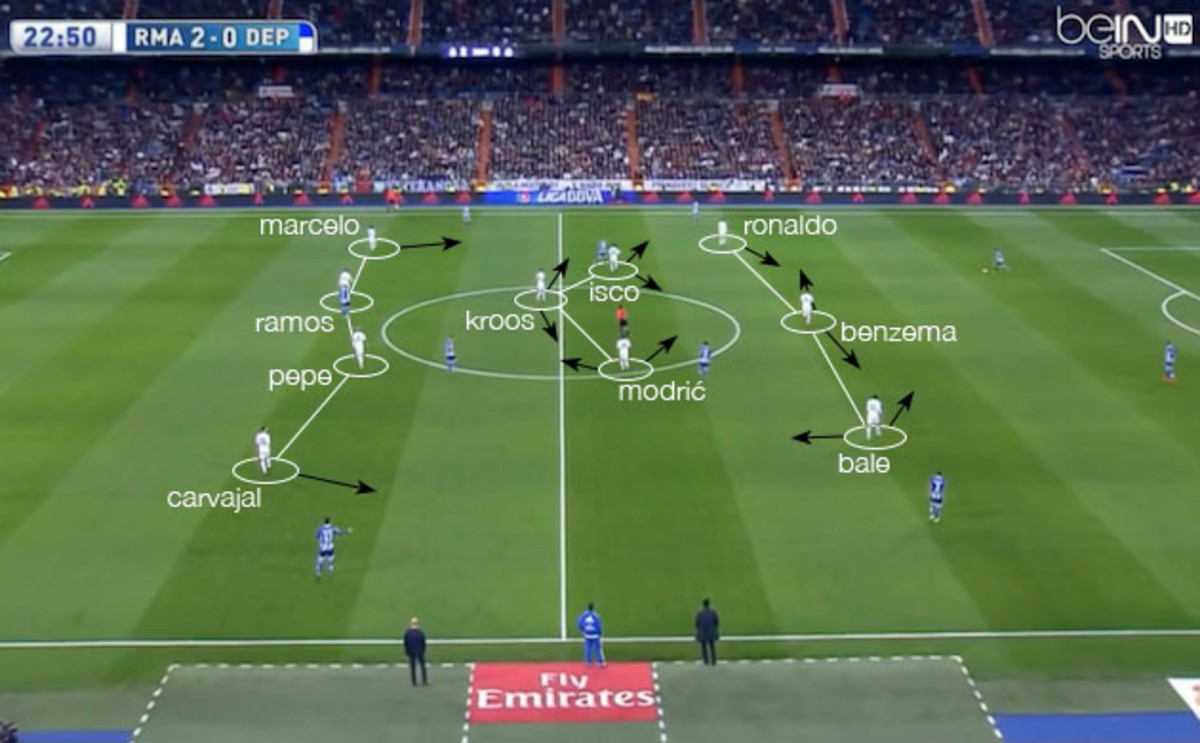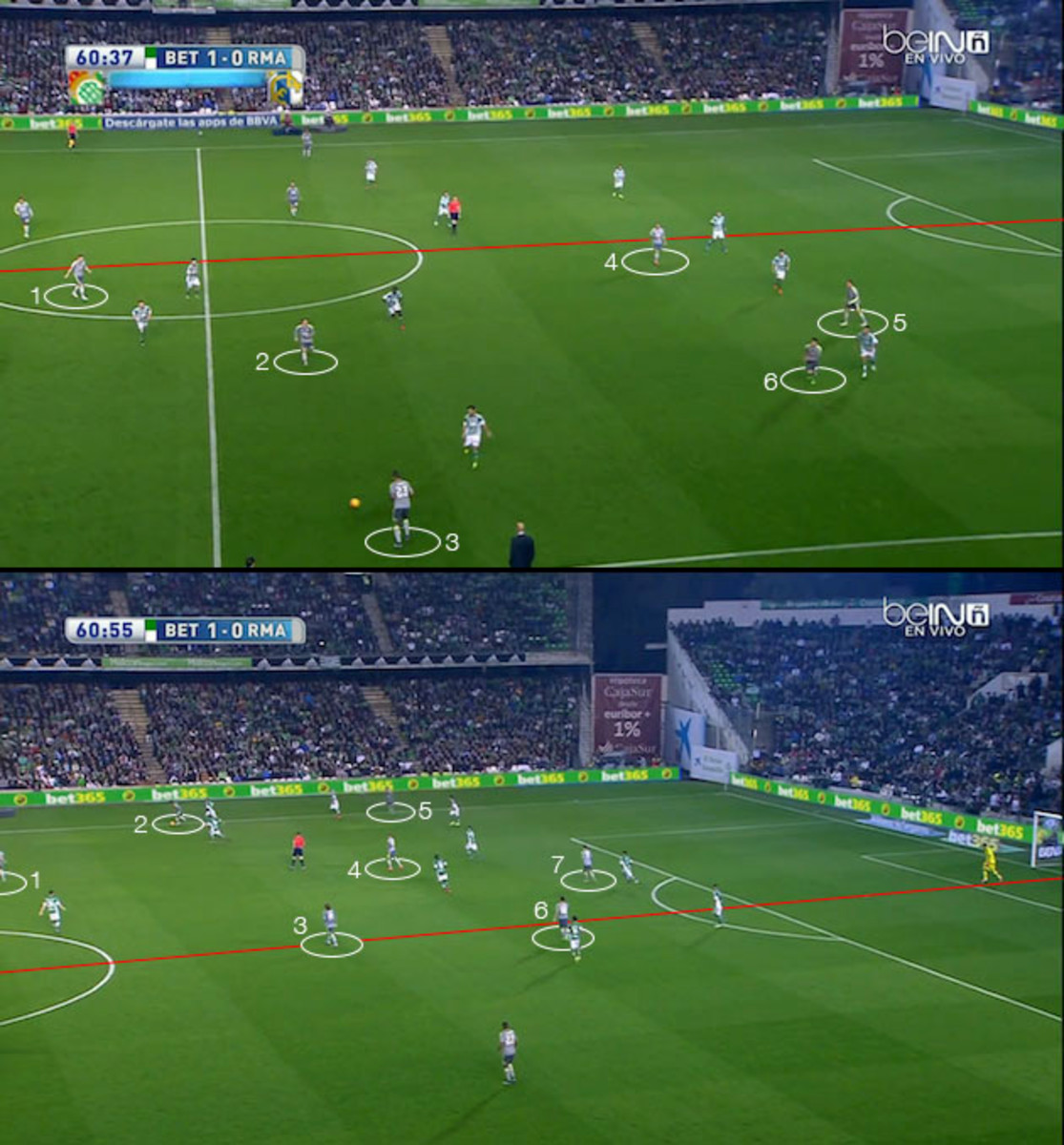Real Madrid midfield structure a focus of manager Zinedine Zidane's tactics

After a rousing start under Zinedine Zidane, outscoring the new manager’s first two opponents 10-1, Real Madrid hit a bit of a snag in drawing Real Betis, 1-1, last Sunday. The result was a reminder that, although Zidane has energized his team and raised its performances as a new boss tends to do, Real still has plenty of work to do to return to its dominance under Carlo Ancelotti.
Zidane’s first three games came against relatively easy opposition—Deportivo La Coruña, Sporting de Gijón and Real Betis—to ease him into the job and allow Real’s players to adapt to his style and principles. Despite some impressive attacking output, the team still showed weaknesses in its structure and some defensive vulnerability that Betis in particular was able to exploit.
Under Zidane, Real has played from a 4-3-3 base shape that mutates into a 4-4-2 as Cristiano Ronaldo stays higher alongside Karim Benzema, leaving Gareth Bale to track back defensively on the right wing. As the last three matches progressed, the system has become more defined each time, eventually resembling Ancelotti’s flexible hybrid formation.

Interchange across the top is nothing new, as Ronaldo, Bale and Benzema continue to rotate freely and fullbacks Marcelo and Daniel Carvajal overlap frequently. Instead, the midfield trio of Toni Kroos, Luka Modrić and Isco has been the most intriguing aspect to watch develop.
It’s notable that Zidane prefers Isco to James Rodríguez in the middle. Rodríguez has featured primarily on the wing and has only started once under the new boss, with rumors of animosity between the two running rampant in Spanish media.
Isco has adapted gradually to his role, balancing the need to cover for Ronaldo defensively but also maintain a central presence in attack. His focus has turned from the wide-left channel to the left half-space and farther in.
Atletico, Real Madrid transfer bans have ripple effect across Europe
Against Deportivo in Zidane’s first match, Real couldn’t gain much of a hold on the midfield because of a lack of presence in the No. 10 space. In the following two matches, Isco’s starting position closer to the middle of the field mitigated that problem, though he still pulled wide as the situation dictated. Kroos, meanwhile, continues in his role as the single pivot that he adopted so well under Pep Guardiola at Bayern Munich.
Modrić runs alongside him in the central channel, but he flares out to the right half-space often and is usually slightly higher up the field in all phases.
However, since the Croatian remains better suited to a linking role than playmaking responsibilities, he couldn’t provide the attacking thrust needed when Isco floated too wide. Isco’s repositioning allowed for much better movement and structure through the middle, and the midfield trio’s understanding clearly grew as time progressed.
Now, their rotation and exchanging of places with players in the other blocks (pulling wide to combine with the fullbacks, for instance) seems smoother. The flowing interchange is much more difficult to track than the stagnant structure at the end of Rafa Benítez’s tenure and even the first match of Zidane’s.
The most obvious incarnation of Real’s structural issues this season came in its embarrassing loss to Barcelona in El Clásico. The team resembled a large circle with no players in the middle to receive the ball, leading to aimless long balls and a predictable attack.
The 5-0 win over Deportivo, despite what the score might indicate, wasn’t much better in that regard. Kroos and Modrić remained too low and Isco too wide to provide the proper angles of support in the build-up. Madrid relied primarily on crosses to create opportunities, which to its credit, were finished impressively.
The key issues, arguments in Lionel Messi's tax fraud case
The disconnection between lines improved greatly in the 5-1 dismantling of Gijón a week later, though Real’s ball retention and circulation were also helped by an opponent sitting far back in its defensive block. Still, the team showed flashes of the type of possession Zidane wants, completing a string of 28 consecutive passes to score its fourth goal and an 11-pass sequence for its fifth.
Madrid began to exhibit something of a combination of Ancelotti’s free-flowing structure and a positional discipline in midfield akin to the type Guardiola teaches. In any case, the four goals in 18 minutes against Gijón showed that this team can be powerful and entertaining.
However, against Betis in Sunday’s 1-1 draw, Real again struggled to play through the middle or even get past the opponent’s first two lines of pressure. Kroos dropped between the central defenders often in the build-up, but Pepe and Raphael Varane didn’t open wider to provide proper angles of support, stifling the team’s ball circulation.
Without proper spacing, ball movement becomes simple to defend, and the center backs and central midfielders couldn’t often connect even when faced only with Betis’ two forwards. Instead, they sprayed the ball wide and tried to build through the flanks.

Both of Zidane’s substitutions against Betis were in wide-right positions, bringing Carvajal on for Danilo and Jesé on for Rodríguez. Carvajal’s introduction in particular energized Madrid, and the equalizing goal came off a diagonal switch to the right side that finally opened space centrally for Kroos to advance and slip a ball through Betis’ back line.
Madrid overloaded both flanks, often playing with six or seven attackers on the same vertical half of the pitch. Betis’ disciplined 4-4-2 defensive block dictated that in part, but so did the re-emergence of a lack of proper spacing for possession in the build-up.
It wasn’t quite as obvious as against Deportivo earlier in the month, when the wingers and fullbacks on each side pulled so wide that Real had no central presence whatsoever, but it was a slight step back. Implementing a new manager’s style often comes with setbacks, but luckily for Zidane, he still has a couple weeks to finalize his structural changes before Champions League returns.
Perhaps more concerning, especially considering a shortage of quality opposition before playing Roma on Feb. 17, are the defensive gaps that have appeared. Pepe has started every match under Zidane so far, but his lack of discipline has been the biggest exploitable weakness on the back line.
He tends to step into midfield and leave channels for opposing forwards to run into, and his defensive partners don’t condense the space quickly enough to compensate. Betis exploited that on its early goal last week, and it has appeared in other matches as well, although none of Real’s other opponents had the quality to punish it.
As FIFA decisions loom, parties state positions on solidarity, compensation
Other defensive concerns, including the ample spacing between lines that created the need for Pepe to step into the midfield, could also spell trouble. As in the attack, it can be described as a general disconnection between lines, created by a lack of compactness when out of possession.
The resulting gaps lead to individual scrambling all over and crossing zones among the defenders.
Considering the short training time Zidane has had with his team, Real’s results so far have been impressive. With B-team Real Madrid Castilla, he showed that he has the ability to coach at a high level, much like Guardiola did with Barcelona B.
But to compare the two would nonetheless be a false equivalence. The circumstances under which they took over their senior-level teams were far different, and although Zidane is definitely suited for his new job, he will likely need more time to find his feet at the higher level.
Add to it the impending transfer ban and a notoriously trigger-happy club culture, and it could be an interesting first half-season for the French legend at the Santiago Bernabéu. As he has so far, Zidane will have to work quickly—and creatively—to get Real Madrid playing to its potential again.
